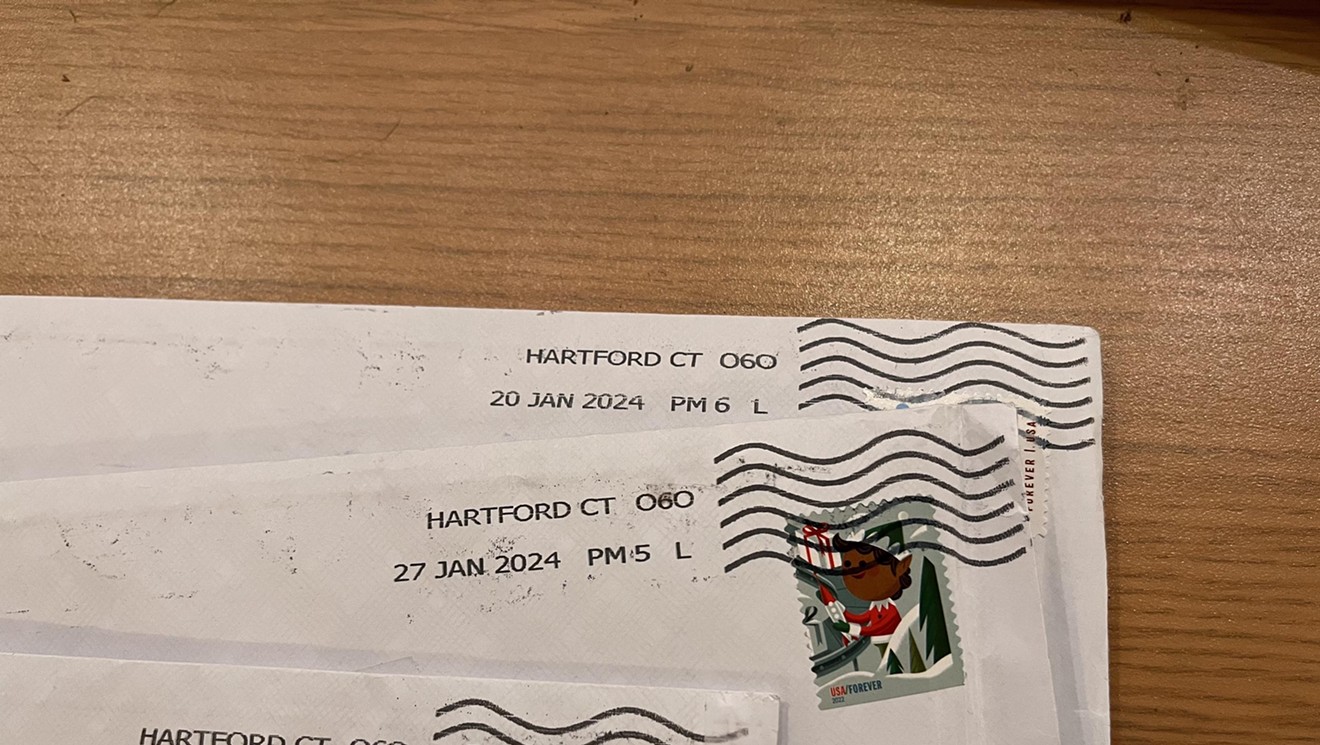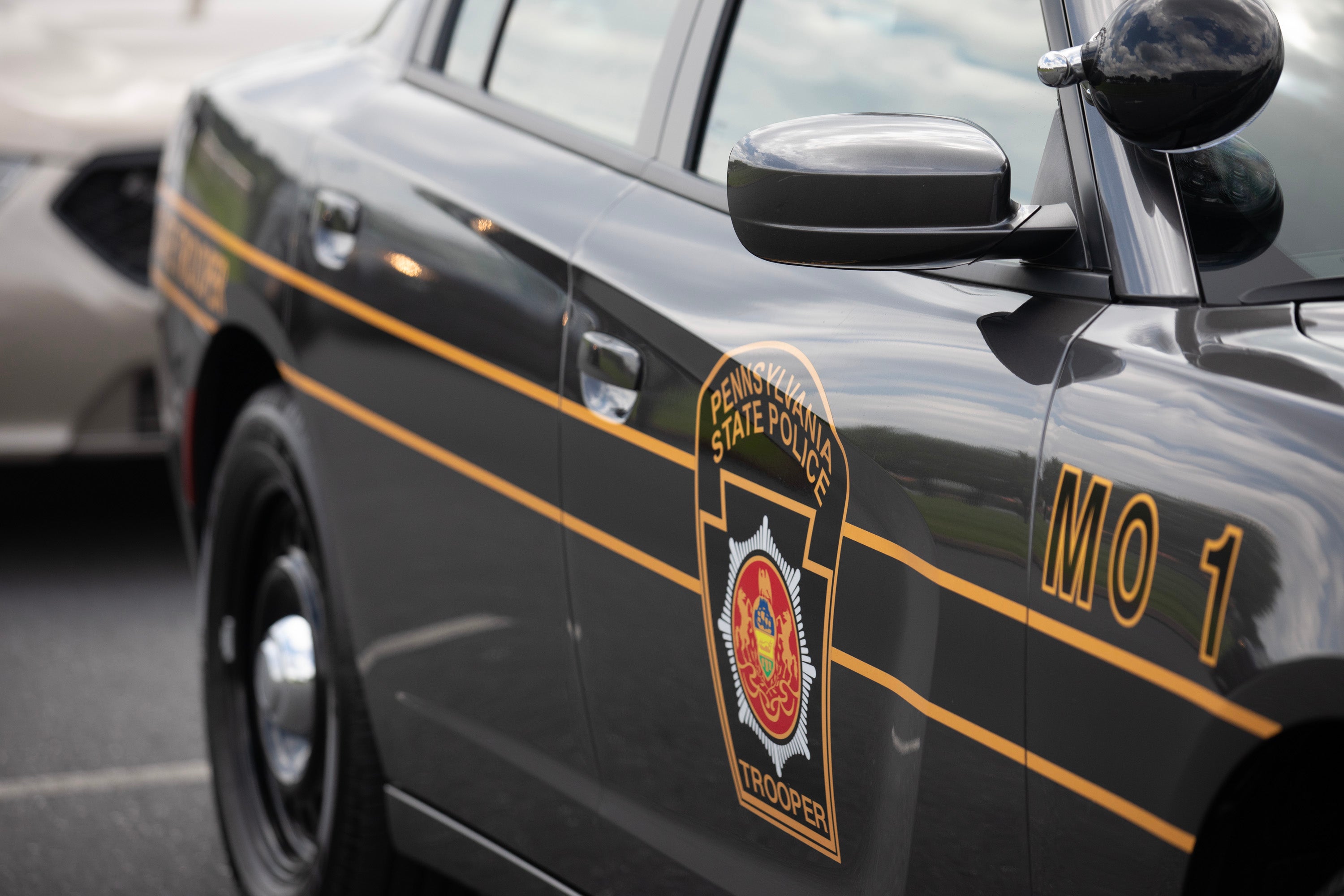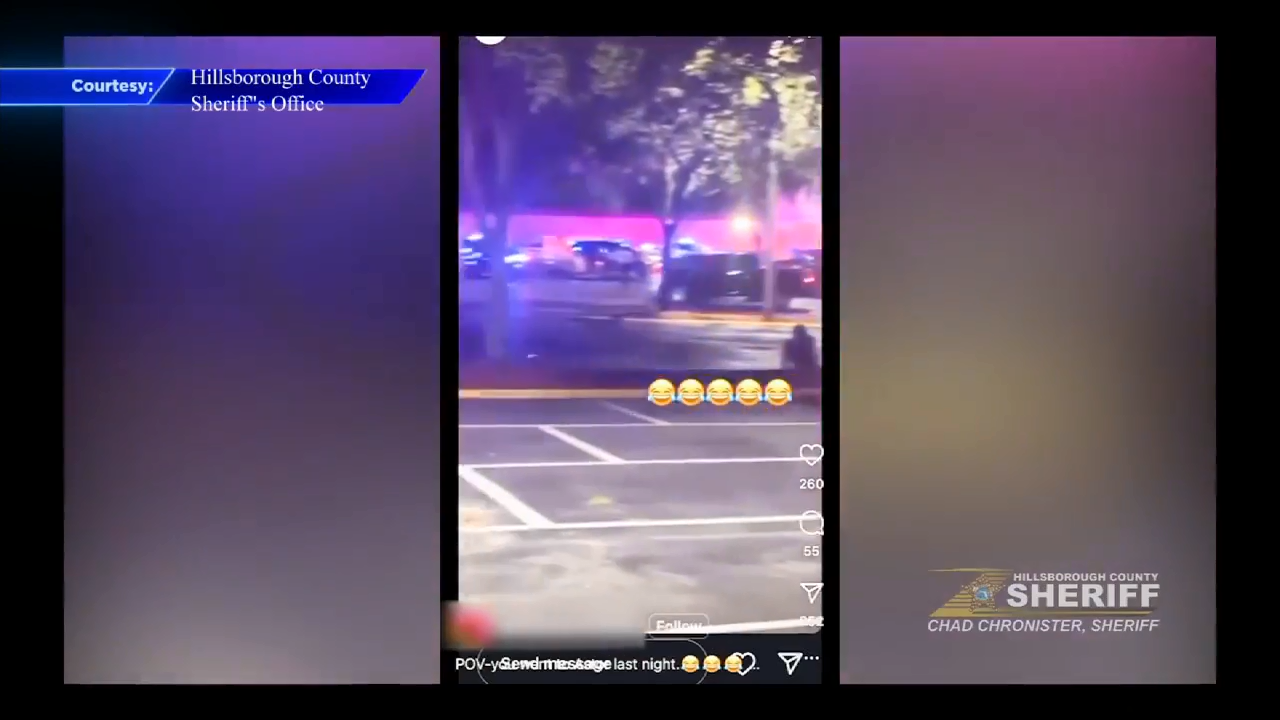Seattle, WA
OPINION | An Emerald Built on Faith | South Seattle Emerald
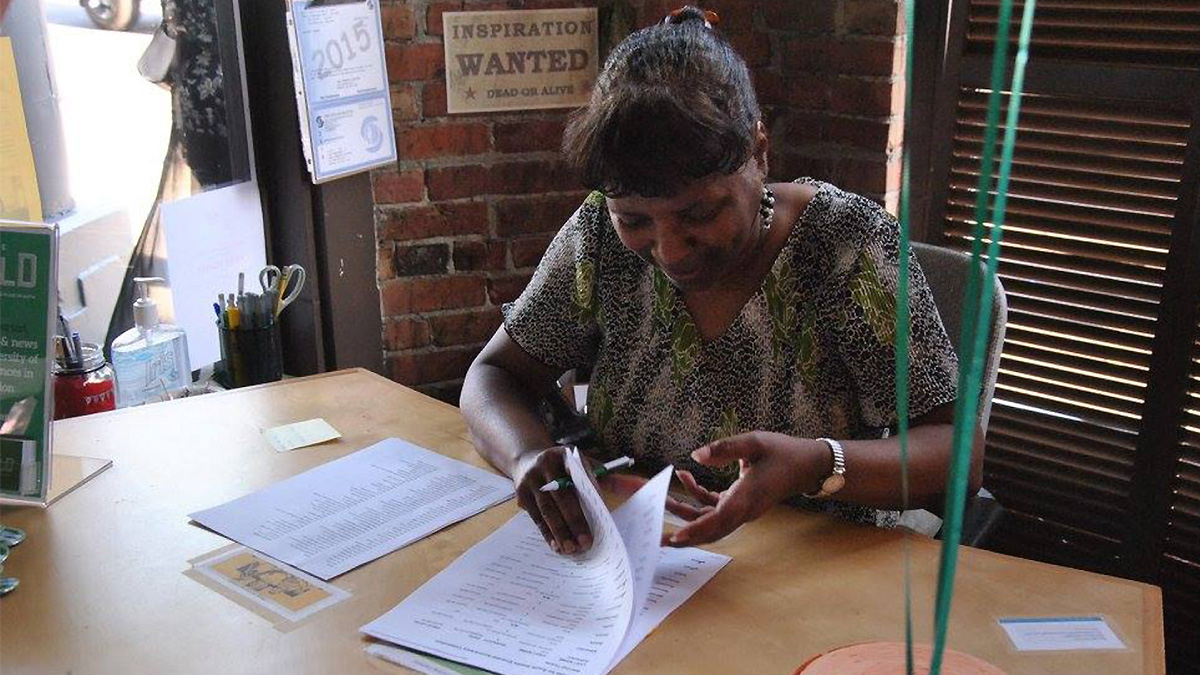
by Cynthia Green
Founded in 2014, today marks the 10th anniversary of this publication. We asked Cynthia Green, one of its founders and past board members, to share what reaching that milestone means to her.
Faith will take you far. That phrase was on my mind as I woke up this morning and reflected on the 10th anniversary of the South Seattle Emerald.
Ten years ago, I sat at the dining room table of my old home and watched my exhausted 30-year-old son furiously type away on a new article. I edited the one he had just finished five minutes ago, and I would soon transcribe an interview for him so he could write another story early the next morning.
Those were the early days of the Emerald. It was just the two of us and his father Phillip back then. Marcus would juggle part-time jobs at the League of Women Voters and Big Brothers Big Sisters and then go out to report, write, and post articles on the Emerald. Phillip would financially support the paper, so Marcus could pay the occasional contributor he could find $50.
I would stay up most of the night transcribing, editing, and copy editing. I’d even sometimes accompany him on interviews and assignments. Now, I think back to how strange it must have seemed to some people: a novice reporter and his 65-year-old mother showing up to press conferences and protests to represent a paper few had ever heard of, while we handed out flimsy homemade business cards we printed at Kinko’s.
But we didn’t care.
We were beyond tired and frustrated with how mainstream media constantly portrayed our community. If you believe the depiction most often found in most media outlets, then our community produced nothing but drug addiction, domestic violence, and crime.
Rarely was that portrayal challenged, and even rarer were there actual voices present in media from our community to speak for themselves, to talk about the beauty, life, and positive aspects of our collective home of South Seattle.
Too often absent from newspaper columns and television screens were the authentic voices of those who have made our community the uniquely vibrant and sensational place it is: People of Color, seniors, youth, working-class residents, activists, educators, and our immigrant, Jewish, Islamic, and LGBTQIA+ community members.
Too often, their lives were reduced to soundbites and statistics. Too often, their concerns were dismissed and deprioritized because of where they lived.
Whether the Emerald lasted 10 hours, 10 days, or, now, 10 years, we knew it needed to exist to tell the stories no one else would tell, either because it wasn’t feasible for them to do so or because they just didn’t care.
Telling those stories and doing it in a way that tells the full story, where human beings are holistically portrayed — and not the fast story that decomposes soon after you finish reading it — remains the vision for the Emerald.
That vision has led us to share the stories of people like Bill Austin. No other media outlet wanted to chronicle his years-long fight to liberate his wrongly convicted son Nathan — who was struggling with drug addiction — from incarceration. Nathan needed treatment, not imprisonment. As Bill would tell me and Marcus, most media viewed his son as “just another Black drug addict,” unworthy of any concern.
It also allowed us to tell the story of Michael Flowers, who was killed during a home invasion. Following his death, most media reports painted him, the victim of an act of murder, as a man deserving of his fate. They resurfaced negative aspects of his past, none of which had any bearing on his murder. His family was infuriated, as no media was willing to correct the record of his life — none but the Emerald.
We presented the story of Michael’s life as a full human being, not a man defined by his worst mistake. To this day, his mother Mary reads our story about Michael whenever she finds herself missing him.
This vision of the Emerald that began as late nights at a dining room table has only endured because of the contributions of so many people from our community through the years. During our early years, people wrote for us, photographed for us, edited for us, reported for us, marketed for us, and advertised for us, while either not getting paid what they deserved or not getting paid at all.
They did this because our vision became theirs: a community claiming its power to tell its own story. A community unwilling to accept falsehoods about itself anymore. A community unafraid to challenge the powerful. A community that will no longer tolerate a muffling of its voice, its concerns, and its brilliance.
This is why I’m not surprised that in our 10 years of existence, so few of our local large foundations and philanthropic organizations (with the acceptation of the Inatai Foundation) have ever given any significant support to the Emerald, despite giving to larger outlets and their proclamations of “prioritizing organizations that serve marginalized communities.”
It’s because we speak too much truth. We challenge systems that produce disparities and inequities. And we don’t pretend that wrong is right, no matter whom the wrong is being done by.
I recently saw a woman about my age while waiting for the bus. She started to talk about the Emerald and said she reads it because it’s where she can find the truth about the community she’s lived in for decades. She only had $5 to donate to us per month, but it’s people like her who have allowed us to persist.
It is our community that we have had to depend on. It is our community that has not let us down in these 10 years, even at times we may have disappointed them.
Though we founded the Emerald, Marcus, Phillip, and I were only ever stewards of its vision. We were never owners of it. The Emerald does not belong to us. It belongs to you. That is why it endures.
It belongs to all those who once lived in South Seattle and have been dispersed throughout King County and Washington but still cling to the Emerald as a point of connection to the sweetest of words: home.
Sacrifice, labor, and, most of all, faith — in and from our community — is what built this home we call the Emerald. And this home will never be for sale, never displace you, and always keep the light on for you.
It has for 10 years. It will for so many more.
The South Seattle Emerald is committed to holding space for a variety of viewpoints within our community, with the understanding that differing perspectives do not negate mutual respect amongst community members.
The opinions, beliefs, and viewpoints expressed by the contributors on this website do not necessarily reflect the opinions, beliefs, and viewpoints of the Emerald or official policies of the Emerald.
Cynthia A. Green is a lifelong South Seattleite. She currently works as a kinship care navigator for Catholic Community Services, helping King County kinship caregivers (including grandparents, aunts, uncles, siblings, and others caring for family members’ children when circumstances prevent their parents from caring for them) find resources and support. Cynthia is also a volunteer tutor with the Lake Washington Youth Tutoring Program. Extremely modest, she will never tell you that the Cynthia A. Green Family Center in Skyway is named after her.
📸 Featured Image: Cynthia Green managing the raffle table at the Emerald’s first anniversary party in 2015. (Photo: Hannah Letinich)
Before you move on to the next story …
The South Seattle Emerald™ is brought to you by Rainmakers. Rainmakers give recurring gifts at any amount. With around 1,000 Rainmakers, the Emerald™ is truly community-driven local media. Help us keep BIPOC-led media free and accessible.
If just half of our readers signed up to give $6 a month, we wouldn’t have to fundraise for the rest of the year. Small amounts make a difference.
We cannot do this work without you. Become a Rainmaker today!

Seattle, WA
SDOT Sprints Toward the End of the Move Seattle Era – The Urbanist
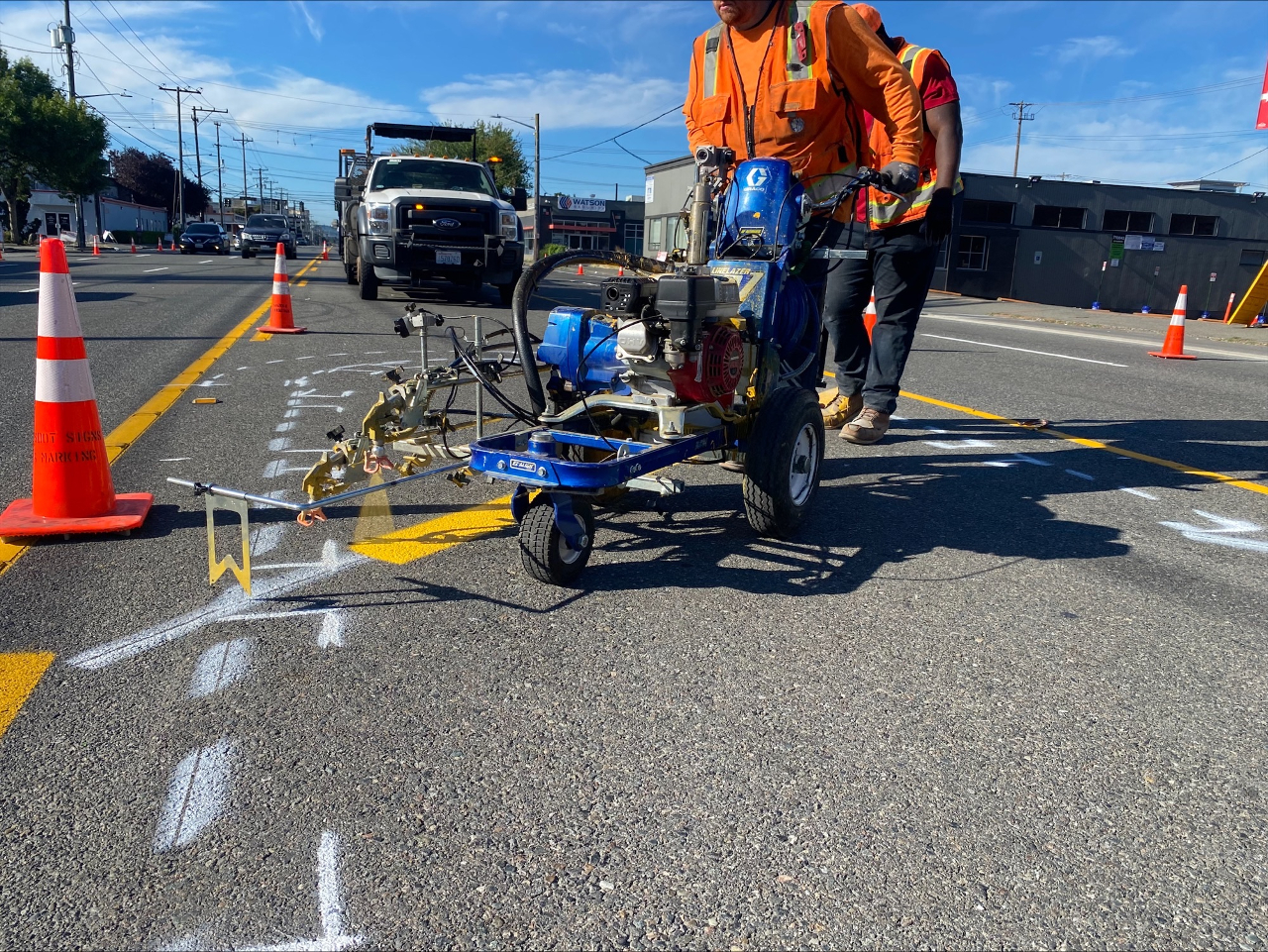
With a $1.45 billion transportation levy proposal in front of the Seattle City Council, attention has turned toward future investments and what they mean for the city’s collective mobility priorities. But behind the scenes, the Seattle Department of Transportation (SDOT) is quietly getting projects out the door in what is on track to be the busiest year for transportation projects in Seattle, ever. The goal is to finish strong on the current Move Seattle Levy, approved in 2015, and make a compelling case for the next transportation levy, which makes up around a third of SDOT’s entire budget. But in so doing, SDOT is also showing how the department has evolved in the past nine years.
So far this year, SDOT has solicited bids from contractors on a huge array of projects, including nearly 10 seismic upgrades on bridges around the city, sidewalk projects, crossing improvements, and a number of big projects that have been in the pipeline for a long time — including the RapidRide J corridor project, the critical first phase of the Beacon Hill bike route, the next phase of Rainier Avenue transit lanes, and upgrades for King County Metro’s Route 40.
All of these projects are on different construction timelines, and different levels of visibility for everyday city residents, but they’re all part of the push at the end of the levy to get things out the door.
“The average number of construction starts we’ve had over the last few years, for contracted projects, is one a month,” SDOT Director Greg Spotts, who has been heading the department since fall of 2022, told The Urbanist. “January, February, March and April, we’ve had eight, so we’ve doubled it to two a month. That’s a step change. That’s not a incremental change. And I’m very proud of the team for doing that. And I think the pace is going to increase even further, in terms of the number of construction starts a month, most of which are levy funded projects, all the way through the end of this year.”
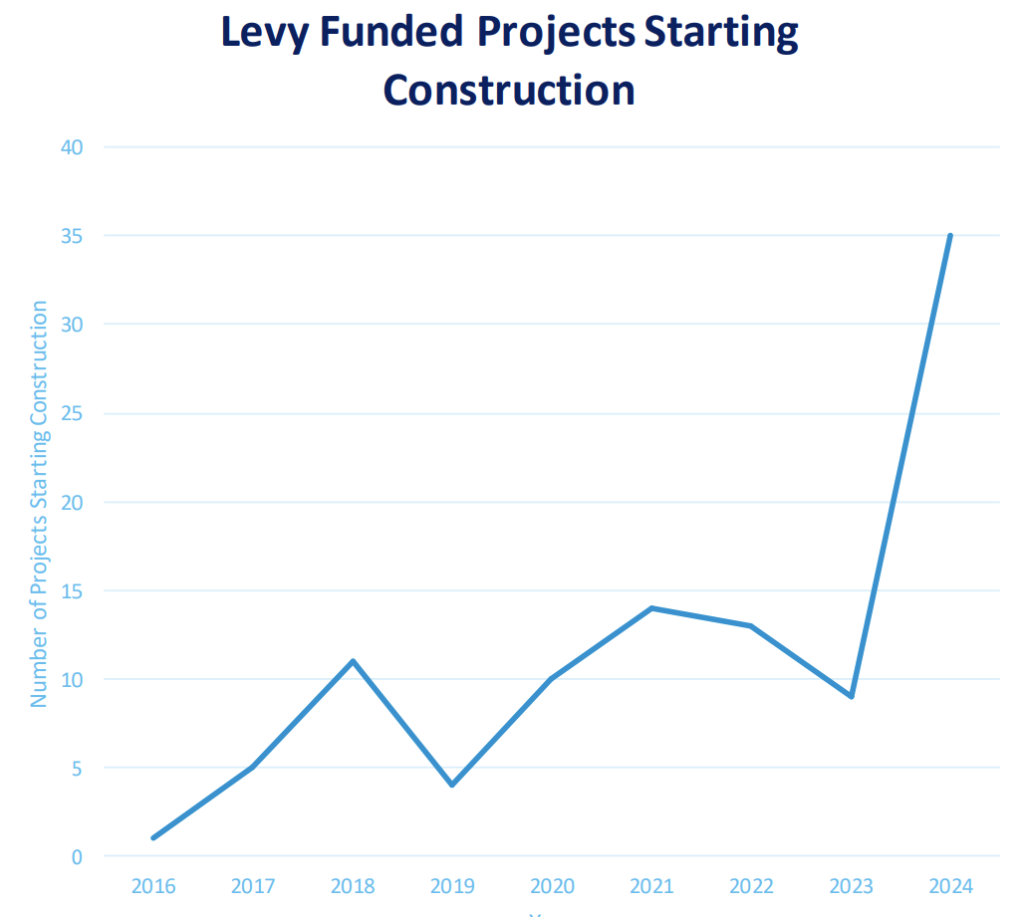
Spotts touts the project delivery machine that the department has been able to create in recent years as producing the results that Seattle residents are seeing in their neighborhoods, something that also extends to smaller projects, delivered by SDOT’s own crews: things like new crosswalks and all-way stops installed near many of Seattle’s elementary schools in the past year, and the pilot bike lane barriers being rolled out in existing protected bike lanes around the city.
“I have made a very significant effort to increase the tempo of how we get these projects through design, how we conduct community outreach in a way that’s efficient for us and the community members, and how we make decisions and confidently carry on and make the next round of decisions to get things into construction,” Spotts said.
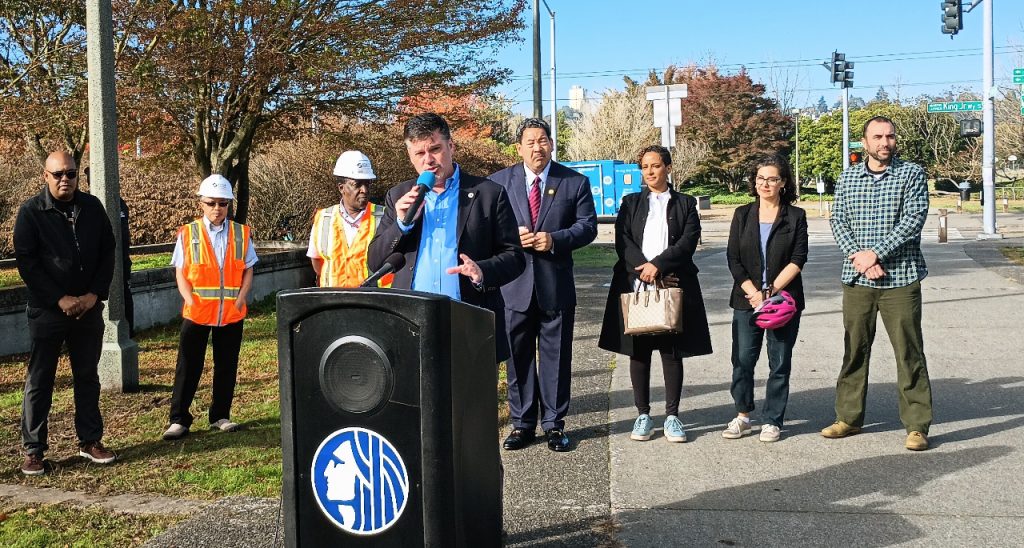
But a big part of the 2024 push is attributable to the 2015 levy’s ambitious goals, which pushed the department to continually look for new resources to get closer. Even if Seattle wasn’t able to deliver seven full transit corridor projects, due in part to a lack of federal matching dollars, having that goal ensured that upgrades to the Route 40, 44, and 48 all moved forward in some capacity. Even though the city won’t hit its goal of implementing 110 miles of bike infrastructure, projects like the Georgetown-to-Downtown bike route likely wouldn’t have happened on their current timelines without that goal.
“There’s a pretty broad consensus within SDOT that we got off to a slow start on the Levy to Move Seattle, and perhaps one of the reasons why was there was kind of a assumption that existing staff could do the job. And if you just almost tripled the size of the levy, it would have made more common sense that you need to staff up,” Spotts said.
In many ways, in the area of project delivery, today’s Seattle Department of Transportation is the one that voters were promised in 2015… it just took several more years than initially expected to get there.
“SDOT’s quite a bit larger in headcount than we were in 2015-2016. And we have a very sophisticated capital projects division and project development division, who are, not just larger, but we’ve actually developed talent during this period,” Spotts continued. “We have people who are much more experienced, who are experienced working with each other; we’ve refined internal systems for collaboration and coordination. So I really believe that we have a capital projects delivery machine that didn’t exist at nearly this throughput capacity back when the Levy to Move Seattle was started.”
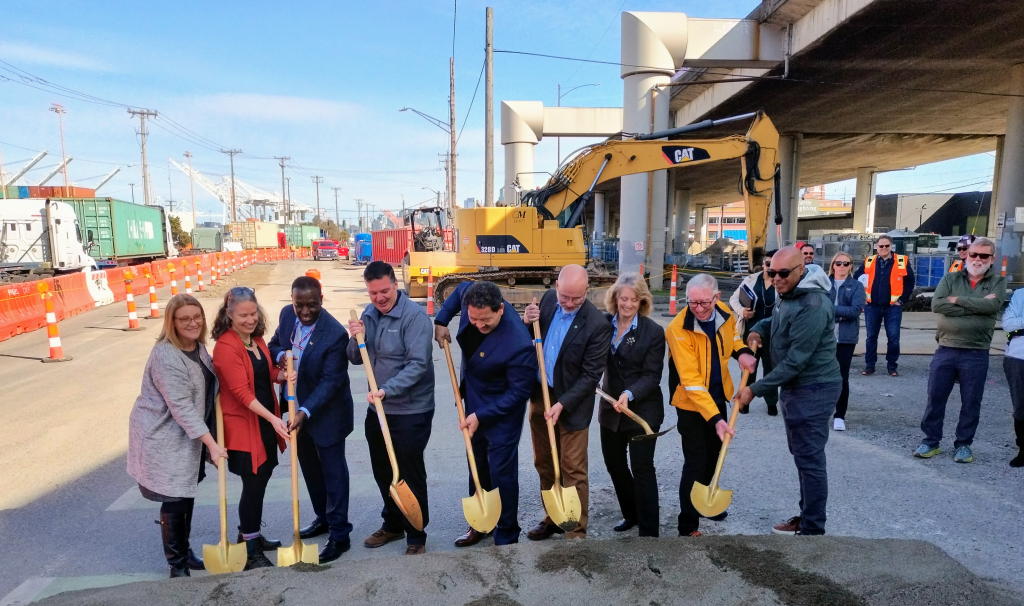
But Mayor Bruce Harrell’s levy renewal proposal, getting its first public hearing today at the Seattle City Council, is less ambitious in its goals and includes fewer guardrails around what specifically the city is expected to spend money on. When Move Seattle included baseline funding requirements in the city’s budget for its three main categories — safe routes, congestion relief, and maintenance and repair — this levy only specifies anticipated spending levels, no minimum requirements. Project lists are currently fairly vague, though there are some specific commitments, including one to construct 250 blocks of new sidewalks by the midpoint of the levy in 2029.
“One of the lessons we learned from the Levy to Move Seattle was to be more cautious about making early commitments that rely on optimistic assumptions about how much grant funding we will receive,” SDOT spokesperson Ethan Bergerson told The Urbanist. Making fewer concrete commitments is a way to ensure the department doesn’t go over its skis, but it also paints a less compelling vision for the city’s transportation vision, and is one factor behind a large push by transportation advocates to make the next levy much bigger and more ambitious.
And then there’s the issue of what happens later this year, with all of these projects out the door and the fate of the next levy very much up-in-the-air. Will a lack of projects in the pipeline lead to a similar lag in project delivery like the city saw at the start of Move Seattle? Spotts says no, adding that they’re thinking differently about this than they have in the past.
“We’re exploring whether there’s some projects that the current levy can’t afford to construct, but could afford to complete design on,” Spotts said. “We want to have basket of projects that could be shovel ready for the next levy.” The department has already received grant funding for two corridor repaving projects, one on E Marginal Way S north of the South Park Bridge, and another on Roosevelt Way NE from NE 92 St to Pinehurst Way NE. Those projects, expected to have multimodal components, are set to be the first to move forward under the new levy.
Spotts also touts the planned goal of protecting 30% of the existing bike lanes in the city with more substantive barriers. “We think we could take that Better Bike Barrier program, and scale it with funds from the new levy. We could be dropping Toronto [style] barriers into existing bike lanes that currently have the paint and post, and that’s something we can do with city forces.”
What SDOT seems to be showing the city in 2024 is that the department is prepared to hit the ground running if voters approve the next levy. But what’s missing is how that levy will actually push the City towards achieving a collective vision that can endure no matter who’s in the Mayor’s Office or at the top of SDOT.
The Seattle City Council is holding the first of two public hearings on Mayor Bruce Harrell’s transportation levy proposal today at 4:30pm. You can sign up to testify virtually starting at 3:30pm, or submit written comments anytime, here.
For more information, The Urbanist has analyzed the mayor’s levy proposal in a series of articles:

Ryan Packer lives in the Summit Slope neighborhood of Capitol Hill and has been writing for the The Urbanist since 2015. They report on multimodal transportation issues, #VisionZero, preservation, and local politics. They believe in using Seattle’s history to help attain the vibrant, diverse city that we all wish to inhabit. Ryan’s writing has appeared in Capitol Hill Seattle Blog, Bike Portland, and Seattle Bike Blog, where they also did a four-month stint as temporary editor.
Seattle, WA
Mariners Use Improbable Rally to Stun Yankees; Here’s How it Happened
The Seattle Mariners beat the New York Yankees on Monday night at Yankee Stadium, 5-4. It was the most improbable win of the season for the M’s, who trailed 4-1 in the top of the ninth inning. The win moves the Mariners to 26-22 while the loss halts the seven-game win streak for the Yankees. As we do after every game, here’s a look at how it happened:
This one is a lesson in “it ain’t over, ’til it’s over.” The Mariners slept walk through the first seven innings, getting nothing going against starter Marcus Stroman. They finally scored against him in the eighth inning when Dom Canzone connected for a home run and ended his night. That made the deficit 3-1, which the Yankees pushed to 4-1 heading into the ninth, which set the stage for the dramatic comeback.
Amazingly enough, after getting Stroman for just three hits in 7.1 innings, the M’s scored four runs off Yankees’ closer Clay Holmes in the ninth, who entered the game with an ERA of 0.00.
Credit to the Mariners’ pitching staff, which turned multiple double plays that kept the team in the game. With the bases loaded in the fourth, Logan Gilbert got Jon Berti to hit into an inning-ending double play. Eduard Bazardo did the same thing in the seventh inning, getting Giancarlo Stanton to hit into the twin-killing.
In the ninth, all the drama started with one out. Julio Rodriguez hit an infield single and Cal Raleigh walked. Luke Raley hit an infield single and Rodriguez scored on a throwing error. Raley and Raleigh each moved up a base.
Then, Mitch Haniger hit a single to bring in a run to make it 4-3 and Canzone tied it with a sac fly. Ty France ultimately had the game-winning RBI with a single to right.
The Mariners’ social media team chronicled it all HERE:
Battled back for the lead! #TridentsUp pic.twitter.com/rXPPoSzexx
— Seattle Mariners (@Mariners) May 21, 2024
Then, in the bottom of the ninth, closer Andres Munoz struck out Aaron Judge on a 101 MPH fastball with one out and one on. He got Alex Verdugo to ground to first to end the game.
Andrés Muñoz, Perfectly Painted 101mph Fastball. 🖌️🎨🔥 pic.twitter.com/zNHAj4WWZg
— Rob Friedman (@PitchingNinja) May 21, 2024
Rodriguez went 1-for-4 to extend his hitting streak to eight games….Munoz got his ninth save and lowered his ERA to 1.77…. Raley went 3-for-4 for the second straight day and is now hitting .311… JP Crawford came back from the injured list and entered as a pinch-hitter, going 0-for-2…Gilbert threw another quality start, going 6.0 innings and allowing three earned runs…Holmes threw 31 pitches for New York, which is big for the rest of the series.
The two teams will play again on Tuesday at 4:05 p.m. PT.
Continue to follow our Inside the Mariners coverage on social media by liking us on Facebook and by following Brady on “X” @wdevradiobrady
RELATED MARINERS CONTENT:
1) Mariners 2024 Schedule, updated with results
2) Mariners’ top prospect Colt Emerson injured, sidelined for up to a month
3) Sam Haggerty out for season after tearing Achilles
Seattle, WA
Hoop dreams are high for the Seattle Storm

Hoop dreams are high for the WNBA season, following NCAA women’s playoff games that garnered record attention. Hoping to capitalize on the momentum: the Seattle Storm.
KIRO Newsradio spoke with several key members of Seattle’s professional women’s basketball team at the team’s new 50,000 square-foot practice facility and headquarters in Interbay, where photos of Storm legend — and newly minted member of the ownership team — Sue Bird, loom large.
New to the team is Nika Muhl.
“I love Seattle,” Mulh said.
The native of Croatia is coming off an exciting NCAA women’s basketball season with the University of Connecticut Huskies. She was the Storm’s first draft pick this season.
“These women that I’m surrounded with are legends,” Muhl said, looking at the Storm’s practice court. “They’re amazing. They’re just inspiring to me, personally.”
Commonalities between Nika Muhl and legend Sue Bird
There are bound to be some comparisons between Muhl and Bird. Both are point guards. While the Storm retired Sue Bird’s #10 jersey number, Muhl wore #10 in college.
But Muhl said that doesn’t necessarily add to the pressure of her rookie year.
“It’s more like a humbling thing,” she said.
“All these little similarities that we have. It’s definitely a cool thing,” she added, gesturing to a photo of Bird. “It’s just a constant reminder of how hard I have to work.”
More on the team: Storm announce the return of Sue Bird
For Muhl and others who are new to the team, there are plenty of established “greats” on the court to learn from.
“Amazing players,” said Muhl. “I’m just trying to learn from them as much as I can, you know, take everything in and be a sponge.”
One of those veterans is Jewell Loyd. The point and shooting guard was drafted by the Storm in 2015.
“We’ve been building this season and I’ve been here the longest. I’m definitely a veteran on this team, so my job is to come in and do my job and lead when I need to lead and have fun,” Loyd said.
When asked how she helps new players adjust to the team, Loyd was matter of fact.
“At the end of the day it’s just basketball,” she said, indicating that every player is here because the team saw potential in them. “No added pressure. Just come in here. Learn. Be a sponge and do what you do.”
What will the Seattle Storm bring to this season?
As for what it’ll take to get this team into the playoffs, “I think people are still trying to figure that out. You know, every year it changes. We’ve obviously won championships here. We’ve had different dynamics with different teams, but every team has a different journey,” Loyd said.
Storm Head Coach Noelle Quinn commented about her role in helping create a championship-caliber team
“A lot of things, come into play,” Quinn said. “Instilling confidence in our players is putting them in positions where they can be successful on the floor. It is coaching them and guiding them to play the way that I’ve envisioned them playing. It takes time.”
As this team works to find its winning rhythm, they are aware that perhaps more eyes — than ever — are on them, because of the surge in popularity of women’s basketball. But to them, it’s not daunting. In fact, it’s long overdue.
“Finally! No, it was not a surprise to me,” Muhl said. “We’ve got to give our flowers to all our vets and the people (who came) before us because, without them, women’s basketball wouldn’t have the opportunity to go even further.”
More sports: UW star basketball player is living her dream, looking toward the future
Loyd shared the same sentiment.
“It’s about time,” Loyd said. “Women’s sports have been, obviously, growing and we’ve been asking for attention for a long time and now it’s here. Now it’s our job to produce and keep doing what we’re doing.”
Quinn agreed.
“I love that we are in a time that eyes are one women’s basketball. The time is now, the time is tomorrow — in the future as well,” Quinn said. “I’m proud to be a part of this movement.”
The WNBA Storm welcome the Indiana Fever — and Caitlin Clark — to Seattle on Wednesday, May 22.
-

 News1 week ago
News1 week agoSkeletal remains found almost 40 years ago identified as woman who disappeared in 1968
-

 World1 week ago
World1 week agoIndia Lok Sabha election 2024 Phase 4: Who votes and what’s at stake?
-

 World1 week ago
World1 week agoUkraine’s military chief admits ‘difficult situation’ in Kharkiv region
-

 Movie Reviews1 week ago
Movie Reviews1 week agoAavesham Movie Review
-

 World1 week ago
World1 week agoCatalans vote in crucial regional election for the separatist movement
-

 News1 week ago
News1 week agoTrump, Reciting Songs And Praising Cannibals, Draws Yawns And Raises Eyebrows
-

 Politics1 week ago
Politics1 week agoNorth Dakota gov, former presidential candidate Doug Burgum front and center at Trump New Jersey rally
-

 Movie Reviews1 week ago
Movie Reviews1 week agoUnfrosted Movie Review: A sweet origins film which borders on the saccharine


